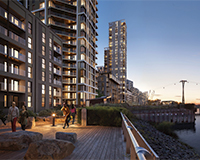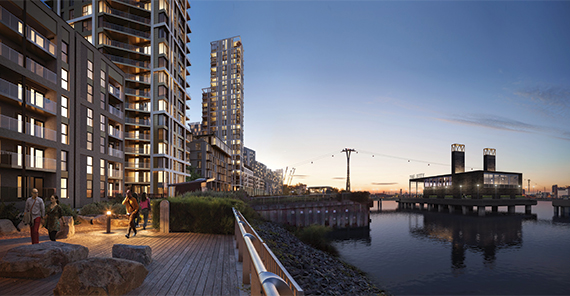Five years ago, this article would not have been written – after all, why develop in the area covered by Zone 2 on London’s transport system when the best sites and richest pickings were in Zone 1? Today, things are different.
First, scope for growth in Zone 1 has become relatively limited. Prime area pipelines are large and, with an increased drive by builders for affordable homes, ambitions have moved out.
Most of London’s large-scale regeneration sites, such as Earls Court, are in Zone 2 or beyond, except for Elephant & Castle which, to the surprise of non-Londoners, is Zone 1.
Second, achievable new-build residential prices in parts of Zone 2 are no longer far away from Zone 1’s less favoured spots. Prices in unfashionable central areas at The Angel or Aldgate, for example, can be £900 per sq ft, while at the Elephant £1,000 is the norm. Over in Zone 2, Battersea, St John’s Wood and Holland Park can now each produce £2,000 per sq ft.
Third, the trend is already under way. JLL’s latest research shows that as of early March 2015, some 26,400 residential units were under construction across its definition of central London, which roughly correlates with Zones 1 and 2 combined.
But whereas there are only 10,300 units under construction in JLL’s core area (roughly Zone 1), the outer core has 16,100.
Furthermore, the number of units under construction in core markets rose by only 9% in 2014, while those under way in the outer core soared last year by 73%.
“Demand has shifted down the value curve in light of stamp duty reforms and the potential mansion tax, so the sub-£1m market has benefited. In addition, buyers are increasingly looking for value and growth potential. Zone 2 locations are more likely to meet those criteria,” says JLL’s head of residential research, Adam Challis.
But development is not happening in Zone 2 just because Zone 1 is full and inappropriate for affordable housing – there are positive attributes, too.
“Planning is anything but typical across the zone, covering various land uses and scales ranging from Canary Wharf in the east to more residential districts such as Putney and Clapham,” says David Whittington, director of Savills’ London planning team.
A wide range of planning authorities of different political colours and with varying priorities give scope for changing residential types and mixed-use, and will open up different funding opportunities compared with the homogeneous Zone 1, even for relatively high-end builders.
“Reduced capital values represent lower risk. Traditionally, there are more buyers for the type of product delivered in Zone 2, who are often owner-occupiers. A scheme in Zone 2 with 50 £1m flats could look safer than a Zone 1 scheme with 10 £5m flats,” says Tom Moore, partner in London residential investment at Strutt & Parker.
Eastern areas of Zone 2 are now particularly attractive, according to Andrew White, associate residential director at Colliers International.
“Large brownfield opportunity areas are being unlocked through rising land and residential sale values as well as proposed new transport infrastructure,” he says.
That transport point is key, for builders and their advisers are desperately trying to identify which locations will benefit most from Crossrail, the Bakerloo Line extension and, ultimately, a north-south Crossrail 2 (see box).
“Increasingly, it is about social and transport infrastructure and connectivity. Journey times are the overriding driver, rather than distance in miles. Sheer convenience of travel is the priority,” says Savills’ head of London residential development, Dominic Grace.
Yet, developers considering Zone 2 should act quickly: there is at least one warning that some areas are already suffering reduced scope for growth. “In the south-west around to the north-west – Clapham and Fulham around to Hampstead – opportunity for development is highly competitive and increasingly saturated,” cautions Colliers’ Andrew White.
London clearly continues to build at a faster speed than transport maps evolve. Is it time for developers to consider Zone 3?
London’s five transport/regeneration-driven growth areas
1. South East London: The proposed Bakerloo line extension will positively affect Southwark, Lewisham, Bromley and open up Brockley, Dulwich and Nunhead – Andrew White, Colliers International
2. Riverside locations: Putney will do well as will Canada Water because of its proximity to Canary Wharf and ongoing regeneration – Tom Moore, Strutt & Parker
3. Hackney and Dalston: Proximity to Liverpool Street will make it will be a quick Crossrail journey to Canary Wharf or the West End – Adam Challis, JLL
4. Hammersmith: Transport links, proximity to Westfield and the West End and widespread regeneration will benefit W6 – Sean Dempsey, Boultbee LDN
5. Earls Court Village/Barons Court: TfL’s tie-up with CapCo to create a modernised Tube station will increase values in Earls Court and is likely to spread to Barons Court – Tom Moore, Strutt & Parker












